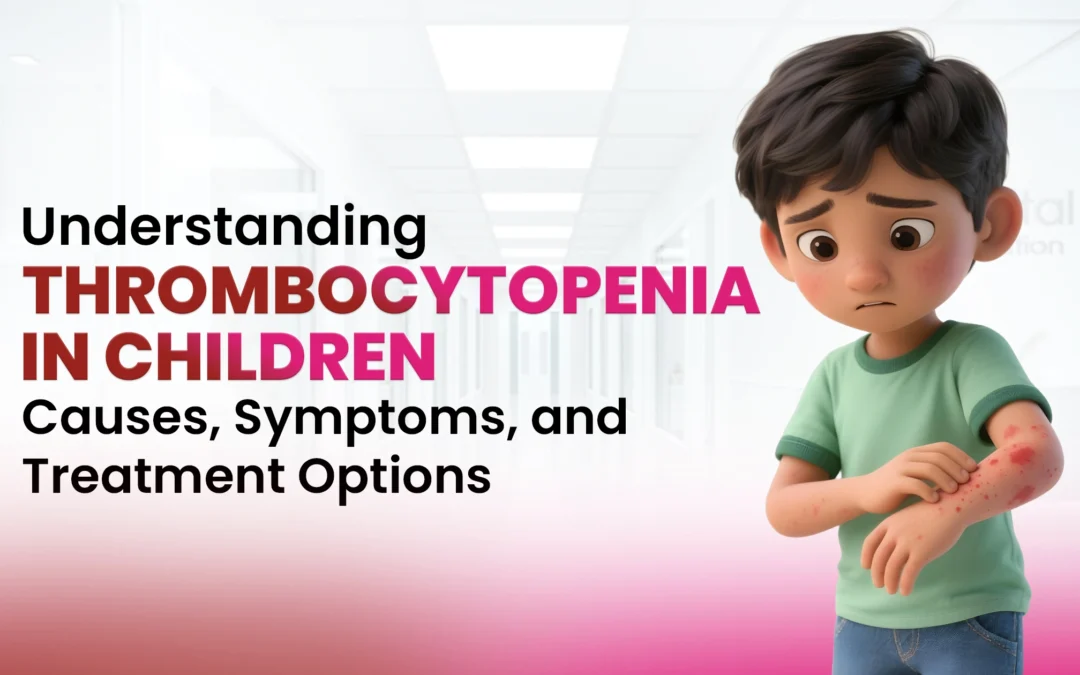Thrombocytopenia — or low platelet count — is a condition that can cause parents a great deal of worry, especially when a child develops unexplained bruises, bleeding gums, or frequent nosebleeds.
As a pediatric hematologist, I often see children referred with “low platelets” in their blood test reports. While thrombocytopenia can sound alarming, it’s important to know that not all cases are serious — but every case deserves proper evaluation.
In this blog, let’s understand what thrombocytopenia means, what causes it, and how it is treated in children.
1. What Is Thrombocytopenia?
Platelets are small cell fragments in our blood that help with clotting — stopping bleeding when we get a cut or injury.
- A normal platelet count in children ranges from 150,000 to 450,000 per microliter of blood.
- Thrombocytopenia occurs when the count falls below 150,000.
- The condition can be temporary or chronic, mild or severe, depending on its cause.
2. What Causes Thrombocytopenia in Children?
There are several possible reasons a child’s platelet count may drop. The most common causes include:
Infections (Viral or Bacterial)
- Dengue, viral fevers, hepatitis, or even the common flu can temporarily reduce platelet production.
Immune Disorders (like ITP)
- The child’s immune system mistakenly attacks platelets, reducing their number in circulation.
Bone Marrow Disorders
- The bone marrow may not produce enough platelets due to leukemia, aplastic anemia, or other marrow problems.
Nutritional Deficiencies
- Lack of folate or vitamin B12 can impair platelet production.
- Drug-Induced or Secondary Causes
- Certain medications, infections, or autoimmune conditions can also cause platelet destruction.

3. Common Symptoms of Thrombocytopenia
Symptoms can vary depending on how low the platelet count is:
- Easy or unexplained bruising (purpura)
- Frequent nosebleeds
- Bleeding gums while brushing
- Tiny red spots on skin (petechiae)
- Prolonged bleeding from minor cuts
- In severe cases, internal bleeding (vomiting blood, black stools, or blood in urine)
Many children may show no visible symptoms — which is why routine blood tests are vital for early detection.
4. How Is Thrombocytopenia Diagnosed?
Diagnosis begins with a complete blood count (CBC) to measure platelet levels.
Further tests may include:
- Peripheral smear (to check platelet size and shape)
- Bone marrow examination (if marrow suppression is suspected)
- Infection screening (for dengue, hepatitis, HIV, etc.)
- Autoimmune tests (if immune-mediated causes are likely)
5. Treatment Options for Thrombocytopenia in Children
Treatment depends entirely on the underlying cause:
Observation & Monitoring
- For mild, temporary infections — no treatment needed except follow-up.
Medications
- If immune destruction is the cause (e.g., ITP), steroids or IVIG therapy may be prescribed.
Platelet Transfusions
- In severe thrombocytopenia with active bleeding.
Treating Underlying Conditions
- Correcting nutritional deficiencies, stopping causative medications, or treating infections.
Bone Marrow-Specific Therapies
For marrow disorders, advanced treatments like bone marrow transplant may be necessary.
6. When to Seek Urgent Medical Care
Parents should consult immediately if:
- Bleeding does not stop after minor injuries.
- The child appears excessively weak or pale.
- Platelet count continues to drop despite treatment.
- There is bleeding from the nose, mouth, or urine.
7. Long-Term Outlook
Most children recover completely, especially when the cause is infection-related or temporary.
Chronic or recurrent thrombocytopenia requires ongoing care under a pediatric hematologist, but with proper treatment, children can lead completely normal lives.
Conclusion

Thrombocytopenia in children can range from a simple viral reaction to a sign of a serious blood disorder.
What matters most is early diagnosis, expert evaluation, and individualized treatment.
If your child has a persistently low platelet count, consult a Pediatric Hemato-Oncologist for accurate diagnosis and specialized care.

